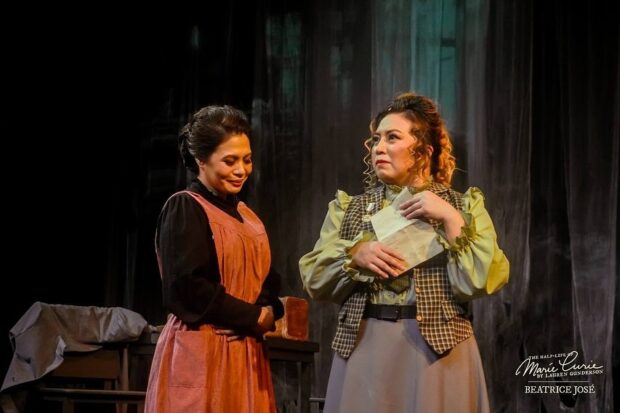Girlhood and female rage go hand in hand with talks of science and intrigue in this fictionalized snapshot of Marie Curie’s life
Girlhood and female rage are two popular and celebrated pop culture phenomena today, thanks to their active reclamation and validation of women’s expression.
In the concept of girlhood, we see the unapologetic expression of softness. Think the current obsession with all things coquette: ribbons, lace, flowers, dresses and Mary Janes. It’s the celebration of slow afternoons and weekends spent with girl friends in quaint markets, or bookstores, or coffee shops.
In contrast, but equally prominent, there’s female rage: the uninhibited expression of pain and anger. The permission (or lack thereof but doing so anyway) to be loud about your feelings, and bringing to light the situations and circumstances that cause these feelings. Sometimes it’s injustice, discrimination, or even the limitations of existing in a female body. Other times, it’s heartbreak and disrespect.
In “The Half-Life of Marie Curie,” we see all these elements, compounding and reacting, exploding into a mixture of anger, worry, and sadness induced by heartbreak and controversy, transformed by the power of female friendship into calm joy, inspiration, and ingenuity.
The play by American playwright Lauren Gunderson was staged last month by MusicArtes at the Ateneo de Manila University’s Arete. It is its first Philippine staging, featuring seasoned theater actors Missy Maramara and Caisa Borromeo.

The two-hander follows Marie Curie (Maramara) in a precarious period of her life: Though she had just been recognized for her work in both chemistry and physics (with two Nobel Prizes!), she is also dealt a devastating blow to her reputation as tabloids relentlessly publish gossip about her affair with a fellow scientist.
Through this, she is anchored by her best friend, electromagnetic engineer and suffragette Hertha Ayrton (Borromeo). Ayrton whisks the distraught Madame Curie off to her seaside home in Britain.
While we mostly think of Marie Curie as one of the world’s great scientists, the play shows us the human—the woman—behind all these achievements. We witness Curie as a woman who gets just as affected by others’ opinions, a woman who feels fear and worry, who feels pain and grief over love lost.
Curie’s friendship with Ayrton is also a beautiful reminder of the power that female friendships hold. Ayrton was a beacon of light for Curie, especially in that period of her life, and it goes to show that no matter how strong we women can push ourselves to be, we’re much stronger together. Empowered women empower women, as we say, and that mantra rings loudly in “The Half-Life of Marie Curie.”
The play, directed with such care by Kiara Pipino, gives us moments of tenderness between these two remarkable women, showing us not only each woman’s brilliance (especially as scientists) but also their beautiful dynamic as friends.
Borromeo’s lively, animated, headstrong Hertha is the perfect contrast to Maramara’s worry-ridden Marie, and both actresses demonstrate the complexities of both women. As a result, we’re treated to a balance of laugh-out-loud moments as both Marie and Hertha take jabs at the patriarchal society (“The shit we go through just to have a thought,” is just one of the clapbacks Hertha says), tempered by more sentimental exchanges between the two women.
What’s also remarkable about the play is how it reflects very real emotions and experiences. While not everyone can relate to being scientists or genius inventors, we can relate to the feeling of pouring so much of ourselves into our work, only for credit to be taken by others (often, men). We can relate to loving people who promise to be with us, only to be down as they flake at the first sign of difficulty. And of course we can all relate to enjoying talking about all our lives’ highs and lows over glasses of our favorite liquor.
Perhaps some can even relate to that greater heartbreak of losing a friend, of not seeing eye to eye and the pain of having your vulnerabilities—which you’d trusted them with—be used against you.
“The Half-Life of Marie Curie” takes us through all these emotions, with a script that is filled to the brim with lines empowering to the modern woman. The beauty of the script is that the lines speak not just of the era during which the story was set, but even to the present.
As Hertha encourages Marie to attend the Nobel Prize dinner despite the (male!) members not wanting her to be there, we are reminded in the same way of the importance of taking up space.
Watching Hertha and Marie support each other, exchange their deepest thoughts on all things—all the way from the wonders of science and research to the follies of relationships—reminds us too of the joy of having girl friends.
If you’re like me and you belong to similar circles as I do, you are likely not the type of person that needs to be reminded of the power of women. It’s also likely that you believe the same thing, and you don’t need any more proof of this universal truth.
We know the immense power and strength women hold—we know it deep in our bones!—but, undeniably, it’s nice to be affirmed. It’s good to have this fact validated often, even more so whenever we see instances of others discrediting women’s achievements and trampling on women’s rights.
And how vindicating it is to witness beautifully told stories of strong women, especially on stages that could reach and touch so many young minds and hearts.